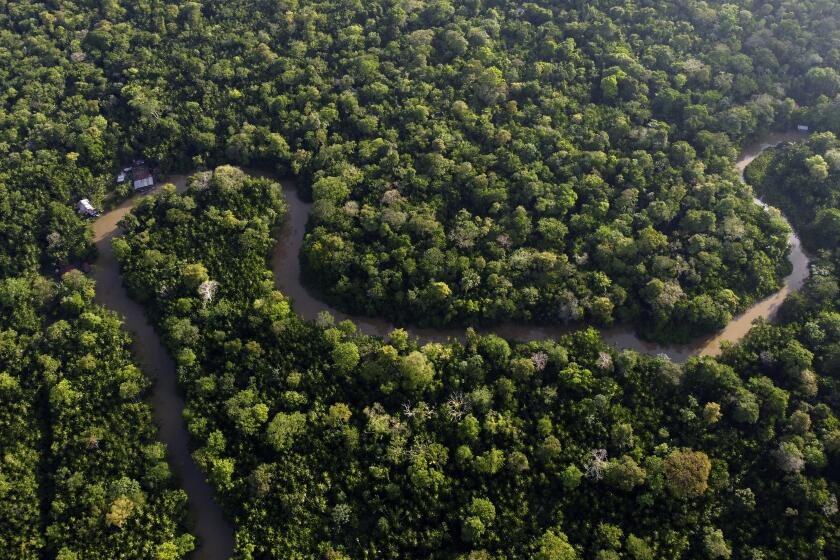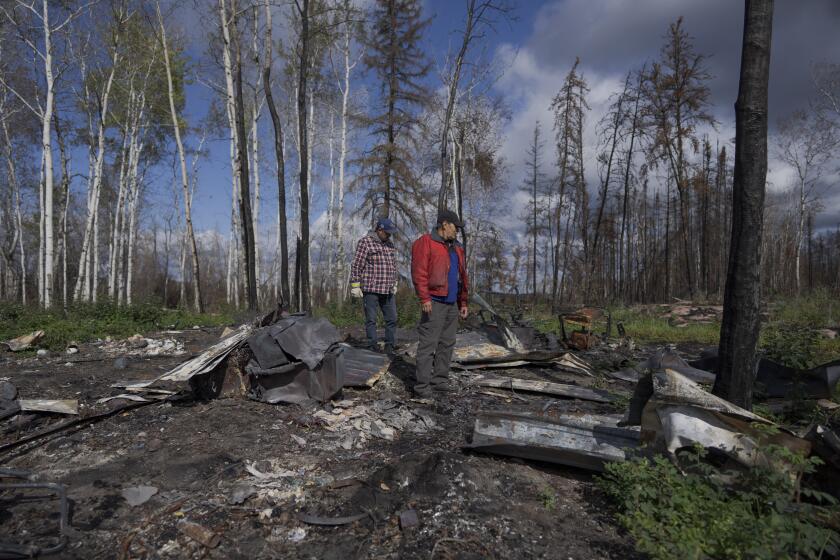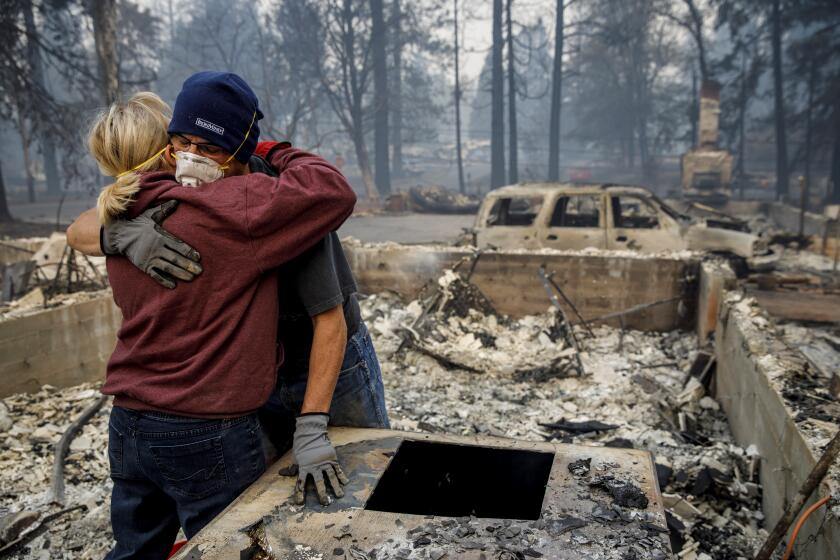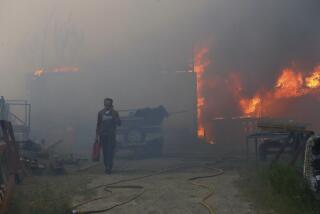Fires in Brazil threaten jaguars, houses and plants in world’s largest tropical wetlands
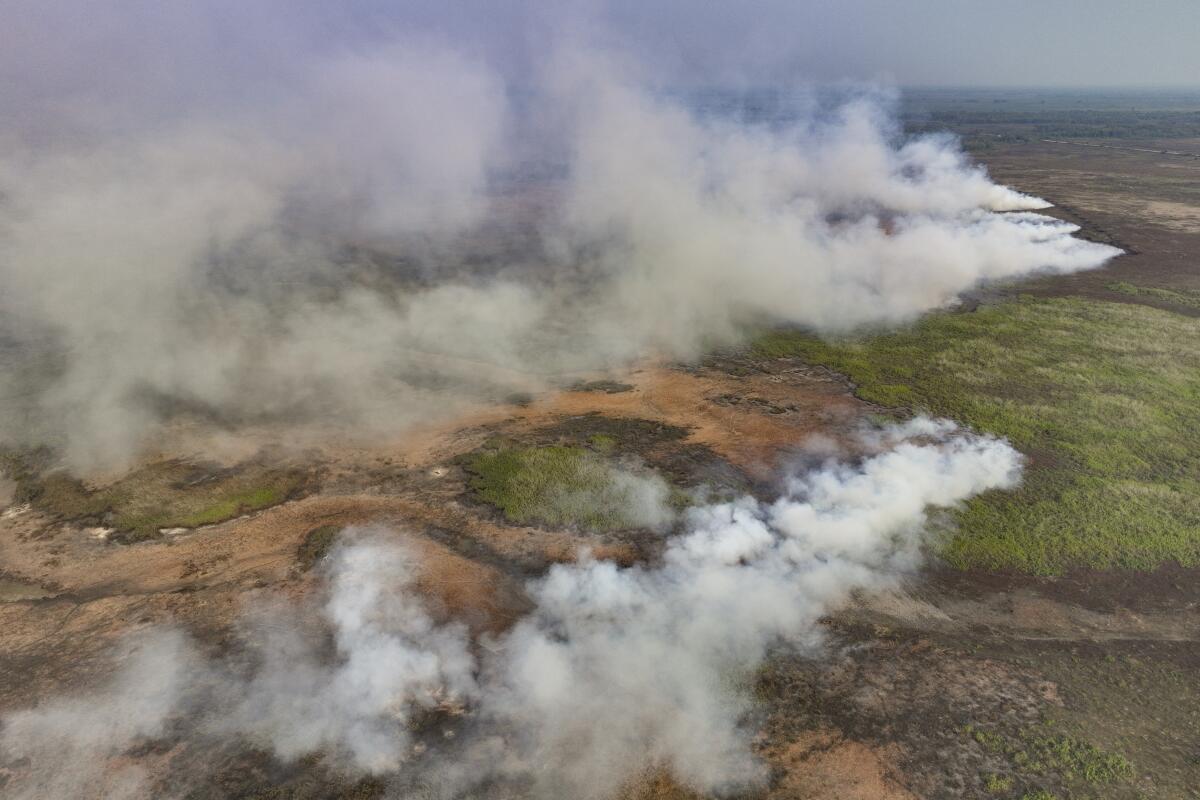
- Share via
POCONE, Brazil — Firefighters in Brazil’s Pantanal wetlands this month celebrated the end of the fire season on Facebook, saying in a Nov. 7 post that “it is a relief for everyone who lives in the region.”
They spoke too soon.
In the first two weeks of November, fires fueled by unusually dry and hot weather destroyed nearly 1.9 million acres — almost 3,000 square miles — of the world’s largest tropical wetlands, preliminary figures from the Federal University of Rio de Janeiro show. This accounts for 65% of the damage done by fires in the region this year.
Brazil’s National Institute for Space Research, a federal agency, detected 3,380 fires in the Pantanal in the first 17 days of November, compared with just 69 in the same period a year ago.
The Pantanal holds thousands of plant and animal species, including 159 mammals, and it abounds with jaguars, according to the World Wildlife Fund.
During the rainy season, rivers overflow their banks, flood the land and make most of it accessible only by boat and airplane. In the dry season, wildlife enthusiasts flock to see the normally furtive jaguars lounging on riverbanks, along with macaws, caimans and capybaras.
Much of the Encontro das Aguas (Meeting of the Waters) park at the border of Mato Grosso and Mato Grosso do Sul states — known for its large jaguar population — had turned from emerald green to dark brown.
A team of Associated Press journalists on the ground spotted a large jaguar licking its paws by the riverbanks, lying on a bed of burned vegetation.
Taylor Swift postponed her Saturday show in Brazil amid heat wave in Rio de Janeiro. One of Swift’s fans died at her concert on Friday night after passing out.
“If this continues every year, there won’t be any more [jaguars] — they’ll go away, they’ll find a way, like people and run to the city,” said Leonisio da Silva, a 53-year-old resident of the park. “It is going to end.”
Jaguars in the park, which covers more than 400 square miles, are accustomed to human observation and have been a top ecotourism draw for years. Their preservation and that of their natural habitat are essential to the region.
Firefighters, troops and volunteers are working night and day to try to stop the fires, which are threatening not only the region’s rich fauna and flora but also homes and tourist guesthouses.
There is little outlook for any near-term help from rainfall.
It has been 14 years since the eight countries in the Amazon Cooperation Treaty Organization have convened for a summit.
“This is so atypical,” said Renata Libonati, who coordinates the Federal University of Rio de Janeiro’s alert system for fires in the Pantanal. The fire season usually ends in October, when the air gets more humid and it begins to rain. “What we’re seeing is an extension of the fire season.”
Libonati said the heat wave that swept through much of Brazil this week, combined with the El Niño weather phenomenon, led to higher temperatures and drier weather conditions.
Firefighters and authorities in the Pantanal region are also faced with a logistical nightmare.
Angelo Rabelo, president of a local environmental group that oversees a protected area of about 1,160 square miles, runs his own fire brigade, currently consisting of eight members who work alongside a small team of national forest firefighters.
“Access to some areas, especially the fire heads, necessarily implies ... the arrival of helicopters,” he said.
Canadian leaders have insisted the country can exploit its natural resources, protect biodiversity and lead the global fight against climate change.
Mato Grosso do Sul state launched a joint task force Tuesday, mobilizing the state’s entire fleet of aircraft to help firefighters, either dropping water on blazes or flying firefighters to the region’s most remote locations. It also declared a state of emergency in four municipalities most affected by fires and where parks and protected areas were particularly at risk.
The neighboring state of Mato Grosso said it had also strengthened its firefighting force, with about 200 federal and state firefighters on
the ground. Mato Grosso’s environment secretary said the state would invest an additional $1.3 million in the region.
Intense fires were reported around the main access routes to the biome. Videos shared on social media showed a car driving down the BR-262 highway, with flames on each side.
Thick smoke emanating from the fires reduced visibility this week, with the Federal Highway Police closing the BR-262 at one point and reports of a small private plane crashing, injuring four people. Lack of visibility also hindered rescue efforts, firefighters said.
Record heat. Raging fires. What are the solutions?
Get Boiling Point, our newsletter about climate change, the environment and building a more sustainable California.
You may occasionally receive promotional content from the Los Angeles Times.
Some on the ground were growing frustrated with authorities’ seemingly slow response.
Enderson Barreto, a 25-year-old veterinarian in Porto Jofre, a small municipality close to the Meeting of the Waters park, said his and other colleagues’ pleas for help weeks ago went unanswered, until it was too late.
“We alerted several times in relation to the fires,” Barreto said, adding that people told them they were being too alarmist. “Greater energy should have been put out when the fires were not in such large proportions. Today it is totally out of control.”
When he is not rescuing animals from the fires, Barreto is helping firefighters combat the flames. He said the effects were immeasurable.
The Camp fire in Paradise revealed vulnerabilities in forest management, electrical equipment, city planning and evacuations. Has the state made strides against those shortcomings?
Fires are frequent in the Pantanal, and vegetation can regenerate quickly with rain. But when the fires are too intense or attack more densely forested areas, the wildlife that survives is left stranded without habitat.
This year’s fires, for now, are not as severe as those of 2020, when flames engulfed more than 13,500 square miles of wetlands, or about 30% of the Pantanal, killing and injuring countless animals, including jaguars.
Barreto said small reptiles and amphibians seem to be the main victims in this year’s tragedy.
“They are invisible victims, but they are the base of the chain for the balance of this ecosystem,” he said.
More to Read
Sign up for Essential California
The most important California stories and recommendations in your inbox every morning.
You may occasionally receive promotional content from the Los Angeles Times.

